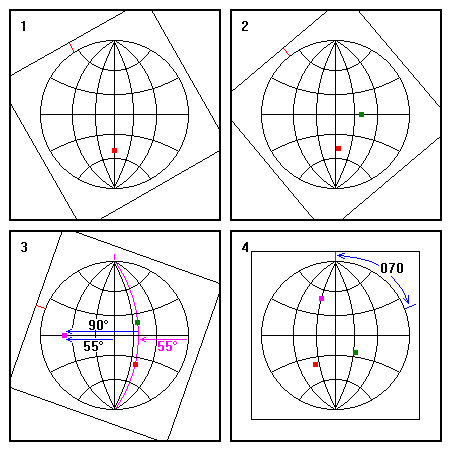Plot the Pole to a Plane Containing Two Given Lines
Steven Dutch, Professor Emeritus, Natural and Applied Sciences, University of Wisconsin - Green Bay
Example
Find the plane that contains two lines, one trending 214, plunging 40, and the other trending 128, plunging 50.
 |
1. Plot the first line. In this case we have plotted the point (red) on the north-south meridian. We count in 40 degrees from the primitive circle. 2. Plot the second line. Here we have plotted the point (green) on the equator. We count in 50 degrees from the primitive circle. 3. Rotate the overlay so the two points lie on a common great circle (purple). Count the dip in from the primitive circle. Locate the pole by either counting 90 degrees from the great circle or by counting the dip starting at the center of the net. Also, draw a tick mark to indicate the strike. 4. Rotate the overlay to its original position and measure the strike. |
This problem is virtually identical to the problem of finding the angle between two lines. To measure the angle, we have to measure in the plane that contains both lines. The only difference between the two problems is whether we are more interested in the angle or in the plane.
In this case we are not required to draw the great circle, but only the pole. This construction is the basis of a common method of fold analysis that simultaneously analyzes many bedding measurements. In such a case, drawing the great circles would result in a hopelessly cluttered diagram.
Return to Course Syllabus
Return to Techniques Manual Index
Return to Professor Dutch's Home Page
Created 13 September 2000, Last Update 13 September 2000